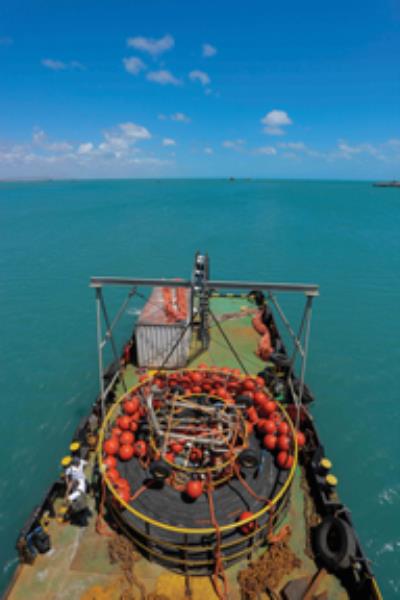08 January 2019
Internet access isn’t just a connectivity issue for the developing world, as ARTUR MENDES explains.
Over the next ten years, emerging markets will experience ever-greater opportunities for their own economic advancement – but only if they can take advantage of the transformative power of the internet.
.jpg)
Developing economies must start to play a more significant role in supporting the ever-growing volume of global data traffic.
According to the ITU, more than four billion people still lack reliable, or in many cases any, internet access. For those that do, a large proportion suffer from limited capacity, leading to their usage being highly constrained. These groups are still largely concentrated in developing regions where delivering connectivity to those who lack access, or an improved service to those who are severely underserved, could create a giant leap forward in economic development.
The potential is so great that the Broadband Commission for Sustainable Development has set targets to increase internet user penetration in developing countries by 2025. At the core is a pledge to increase levels to 65 per cent in developing countries and 35 per cent in the least-developed countries. Typically, the world’s internet and telecoms giants are expected to take the lead on delivering on these targets. However, there is a massive opportunity for emerging countries to take on the challenge of making this happen themselves.
Indeed, the economic benefits could be far more meaningful if this was to be the case.
Many countries have already seen the incredible effect the digital revolution has had in countries such as China where Tencent and Alibaba are now two of the world’s internet giants. Many other emerging countries want to emulate that experience, but how can developing nations rise to the challenge? While investment is required, The biggest risk to extending connectivity to the developing world is thinking of it as purely a connectivity issue. If emerging economies are to capitalise fully on the economic benefits of internet access then we need to think of the challenge in broader terms, and regional players will need to step up their ambitions when it comes to scaling operations.
Investment isn’t the hurdle you might expect
Of course, that is not to say there isn’t a connectivity hurdle to overcome. Demand for connectivity in the southern hemisphere is skyrocketing, but developing countries typically lack the legacy infrastructure that developed economies have invested in over the past 150 years.
When it comes to connectivity infrastructure, one of the key elements is the global submarine cable network. As a result, there is an acceleration in demand for subsea cables to provide the capacity, speed and low latency developing economies lack compared to more advanced regions.
Interestingly though, funding to meet this growing demand does not seem to be an issue. For example, there has so far been USD1.5bn of investment1 in Latin American submarine cable routes in 2017 and 2018. These new routes are mainly being developed in the South Atlantic, an area which is currently known for having some of the lowest levels of connectivity in the world.
Funding and expertise to build these new submarine cable projects come from a wide variety of sources. For example, China Unicom and Camtel have partnered to invest in the South Atlantic Inter Link2 (SAIL) subsea cable which will be built between Cameroon and Brazil by Huawei Marine Networks; China is also involved in the construction of the Pakistan East Africa Cable Express3 (PEACE), again built by Huawei Marine. This is part of the much larger Belt and Road4 initiative, through which Chinese companies are building vast swathes of infrastructure throughout Asia, Africa and the Middle East.
OTT companies are also active investors in submarine cables. One example here is the Monet cable which connects Florida in the US to Brazil in Santos, São Paulo and Fortaleza. As well as Angola Cables, Monet’s owners include Latin American telcos and Alphabet, Google’s parent company.
Crucially though, countries and companies from the global south are also investing as they see the opportunity to exert increasing control over the cable networks and wider economic development efforts in the region. Angola Cables’ own South Atlantic Cable System is an example of this, being the first subsea cable directly connecting South America and Africa with 40Tbps. [See News, Sep-Oct issue.]
As emerging markets continue to connect we will increasingly see new routes being built around the world. However, the new connections and new capacity they bring should only be regarded as one piece of the puzzle if we are to see truly transformative economic growth in the developing world.
Subsea cables are just the first step
While it is clear that the subsea cable market is entering a new era of fast growth, developing regions shouldn’t look at better connectivity purely as an end in itself but also as a spur to opening up untapped economic growth. At the heart of this equation is the increasing value of data as a commodity, both in and of itself.
As more people are brought online who will seek to use the internet to change their lives for the better, and more content is produced and consumed not only in developed nations but around the world, emerging countries need to raise their sights and claim a bigger role in international data markets. This may not be an easy ride. While all telecoms operators must try to cope with the fast pace of technology change in their home territories, those from emerging or developing countries have the additional challenge of overcoming a lack of content allocation locally and a lack of reliable IP telecoms capacity.
As such, developing regions must look beyond cabling infrastructure. Data centre infrastructure in local markets complement planned undersea networks. Developing an ecosystem that allows for IP traffic to be exchanged locally and regionally will also improve the efficiency of networks that are serving the southern hemisphere.
For the truly ambitious providers, there is also huge potential to adopt an international perspective. By building out data centre, colocation and data exchange infrastructure in other regions, both developed and developing, telecoms leaders in emerging markets will better serve the growing demand for digital transformation in their home markets and globally.
In particular, this approach will allow for future interconnectivity with other submarine systems — enabling OTT providers and content delivery networks (CDNs) to quickly reach multiple networks. This will go a long way in terms of levelling the disproportionate nature of the current northern/southern hemisphere divide in IP traffic and data handling.
By taking on this new role, developing nations will enable global companies to overcome previous prejudices or stereotypes and shift their attention to new regions and markets. In turn, this will allow new market expansions with reduced investment risks. A massive opportunity therefore exists for those who seek to connect the developing world – far beyond the immediate opportunity presented by providing the fundamental cabling infrastructure.
Focus on the value-add
To make this leap from a simple pipes model to a content-driven, big data business model, there are several things telecoms providers in developing countries can put in action.
Subsea cables, such as the Monet system being laid here, are providing the capacity, speed and low latency developing economies need. But connectivity infrastructure are only a means to an end are just one piece of the digital jigsaw. 
First and foremost, they must develop product portfolios that meet international expectations. On the one hand, this means evolving capacity services to meet premium expectations – including offering 100 wavelengths and bandwidths of 100Gbps. On the other, it also means looking beyond simple capacity services to incorporate additional IP services like transit, peering, PNIs, MPLS, SDN, and international multi-homed IXP reselling.
Marrying these services (network, IP, IaaS and security) with low latency, ultra-resilient subsea network and international data centre infrastructure can dramatically cut traffic time and costs, opening up new commercial opportunities for providers in developing regions.
Strategically, targeting markets in both the northern and southern hemispheres with potential for high growth will enable the development of cost-benefit-based business models in urban regions and the growth of OTT and CDN ecosystems. Targeted distribution of content and applications to their markets will also be easier.
Adopting an international perspective also impacts how businesses should operate. Providers need to be able to serve global ISPs and OTTs. This means customer support must be delivered by multilingual staff committed to delivering 24x7 real-time network monitoring.
Local growth requires a global view
For developing regions, building successful and profitable new digital economies requires local acceleration of digital transformation. To meet targets for increased user penetration in developing countries in the next few years, these locations will need to lead by example and embrace the opportunities that new technologies bring.
But maximising this opportunity also requires a more international perspective. Developing economies must start to play a more significant role in supporting the ever-growing volume of global data traffic – not just in terms of the fundamental infrastructure, but also in how it is managed and exchanged.
While many US-based global content providers are well-known for leading such developments, new international wholesale carriers from developing economies are the ones to watch as they seek to create new ‘data hubs’ in surprising and unexpected places. Continued exponential demand growth of data traffic means that with the right investments, these new providers have the potential to not only overhaul their economies, but also to change traffic management regimes globally.






